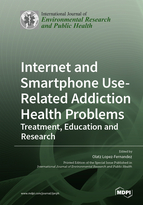Internet and Smartphone Use-Related Addiction Health Problems: Treatment, Education and Research
A special issue of International Journal of Environmental Research and Public Health (ISSN 1660-4601). This special issue belongs to the section "Digital Health".
Deadline for manuscript submissions: closed (31 May 2020) | Viewed by 327869
Special Issue Editor
2. Universidad Francisco de Vitoria, Psychology, Carretera de Pozuelo a Majadahonda km. 1.800, Pozuelo de Alarcón, 28223 Madrid, Spain
3. Centro de Estudios Universitarios Cardenal Cisneros, University College, Department of Psychology, Calle del General Díaz Porlier 58, 28006 Madrid, Spain
4. Hospital Universitario Fundación Jiménez Díaz, Servicio de Psiquiatría, Avda. Reyes Católicos 2, 28040 Madrid, Spain
Interests: addictive behaviours; behavioural addictions; general online addictive behaviours (e.g., internet addiction, problem mobile phone use); specific online addictive behaviours (e.g., gaming, social networking, cybersex); gender issues (e.g., female, male); lifespan issues (e.g., children, elderly); educational technology (e.g., educative innovations, higher education, online learning and teaching, ePortfolios); e-health (e.g., healthcare practices for behavioural addictions, mhealth, serious games)
Special Issues, Collections and Topics in MDPI journals
Special Issue Information
Dear Colleagues,
The previous Special Issue "Internet and Mobile Phone Addiction: Health and Educational Effects" (2017-2018) was a successful achievement, which can be found at https://0-www-mdpi-com.brum.beds.ac.uk/journal/ijerph/special_issues/internet_addiction. The second edition relies on recent developments in internet and smartphone use-related addiction health problems.
The focus will be in its treatment, education and research, as the Special Issue will collect papers that will cover one (or more) of the health problems under study or under the clinical scope.
First, we invite studies on how these problems are being diagnosed, the profiling of these patients, the usual comorbidity, treatments applied, and their prognosis. Second, we want to know how these problems could be tackled from an educational and preventive perspective, if any policy options have been applied and the consequences, if any educational intervention is undertaken, even as a preventive action, or on how education has developed on these health problems. Third, any research focused on the role of the internet in different fixed or mobile technologies is expected. However, the primary interest is in empirical papers and reviews or new theoretical developments are welcome, even if they are focussed on not formally recognised behavioural addictions (i.e., cybersex, online shopping). Other behavioural addictions where the technology has a role which is not primarily the most important (e.g., food addiction, exercise addiction) will also be considered. Thus, contributions should offer new knowledge about how these health problems are evolving worldwide.
Dr. Olatz Lopez-Fernandez
Guest Editor
Manuscript Submission Information
Manuscripts should be submitted online at www.mdpi.com by registering and logging in to this website. Once you are registered, click here to go to the submission form. Manuscripts can be submitted until the deadline. All submissions that pass pre-check are peer-reviewed. Accepted papers will be published continuously in the journal (as soon as accepted) and will be listed together on the special issue website. Research articles, review articles as well as short communications are invited. For planned papers, a title and short abstract (about 100 words) can be sent to the Editorial Office for announcement on this website.
Submitted manuscripts should not have been published previously, nor be under consideration for publication elsewhere (except conference proceedings papers). All manuscripts are thoroughly refereed through a single-blind peer-review process. A guide for authors and other relevant information for submission of manuscripts is available on the Instructions for Authors page. International Journal of Environmental Research and Public Health is an international peer-reviewed open access monthly journal published by MDPI.
Please visit the Instructions for Authors page before submitting a manuscript. The Article Processing Charge (APC) for publication in this open access journal is 2500 CHF (Swiss Francs). Submitted papers should be well formatted and use good English. Authors may use MDPI's English editing service prior to publication or during author revisions.
Keywords
- Internet addiction
- Mobile phone (or smartphone) addiction
- Internet use-related addiction health problems: Gaming, disordered social networking, cybersex, emotional dependence, online shopping, etc.
- Other behavioural addictions which use the technology as a complement: Food addiction, exercise addiction, work addiction, etc.
- Diagnosis, dual pathology, comorbidity, treatments, psychotherapy, prognosis
- Public health, eHealth, mHealth, etc.
- Educational, intervention, prevention, psycho-sociological effects studies






